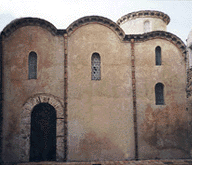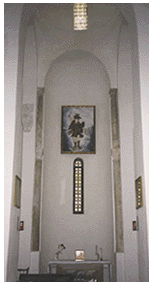...Best of Sicily
presents... Best of Sicily Magazine. ... Dedicated to Sicilian art, culture, history, people, places and all things Sicilian. |
by Carlo Trabia | ||
Magazine Best of Sicily Arts & Culture Fashion Food & Wine History & Culture About Us Travel Faqs Contact Map of Sicily |
This is no accident, as Sicily's ecclesiastical tradition was still essentially Greek (Orthodox) when the chapel was constructed. In times past, the walls probably bore icons in fresco; an icon of Michael the Arcangel was probably present. The subsequent stucco of the same walls was a sixteenth century addition owing to the Renaissance and Baroque movements. Some of the Royal Woods around Altofonte have been preserved, and most of these precious tracts are now protected by barbed wire fences. Like the kings themselves, the deer, boar and wild cats are long gone. Only the trees remain. Considering the number of royal chapels around the Normans' other capital --London-- it's not surprising that at least a few were built around Palermo, once a city of narrow medieval streets and arched Gothic windows. Saint Michael's is one of the few to have survived in anything approaching its original form. Solitary and serene, this tiny chapel, though rarely open to the public, still evokes in the visitor the austere sensation it must have instilled in Europe's wealthiest sovereigns. About the Author: Catanian architect Carlo Trabia has written about medieval architecture for various magazines and professional journals. | |
Top of Page |
 Omnipresent but often hidden, the Norman churches of Sicily exist in a world removed from time. Truth be told, time
itself has not always been kind to these medieval treasures, sometimes modified
or restructured almost beyond recognition over the centuries. One of these
rare places is the Royal Chapel of Saint Michael at Altofonte, a hill town
overlooking Palermo, across the valley from Monreale. Altofonte (literally
"high fount") takes its modern name frrom its mineral springs,
but in the Middle Ages the area was called simply "Parco" (the
park) because it was a vast hilltop forest that served as a royal hunting
ground for the Norman kings. The Royal Chapel is the oldest complete structure
in the town, forming part of what, by the thirteenth century, was a small
monastery. Completed decades earlier, during the last years of the twelfth
century, the chapel is dedicated to one of the saints most widely venerated
by the Normans in Sicily. Today, it forms part of the complex of Altofonte's
Mother Church. Its apse and nave are quite similar to those of the various
Norman-Arab churches around Sicily,
Omnipresent but often hidden, the Norman churches of Sicily exist in a world removed from time. Truth be told, time
itself has not always been kind to these medieval treasures, sometimes modified
or restructured almost beyond recognition over the centuries. One of these
rare places is the Royal Chapel of Saint Michael at Altofonte, a hill town
overlooking Palermo, across the valley from Monreale. Altofonte (literally
"high fount") takes its modern name frrom its mineral springs,
but in the Middle Ages the area was called simply "Parco" (the
park) because it was a vast hilltop forest that served as a royal hunting
ground for the Norman kings. The Royal Chapel is the oldest complete structure
in the town, forming part of what, by the thirteenth century, was a small
monastery. Completed decades earlier, during the last years of the twelfth
century, the chapel is dedicated to one of the saints most widely venerated
by the Normans in Sicily. Today, it forms part of the complex of Altofonte's
Mother Church. Its apse and nave are quite similar to those of the various
Norman-Arab churches around Sicily,  though
its cupola reflects a simpler style not unlike that of many Greek churches.
though
its cupola reflects a simpler style not unlike that of many Greek churches.